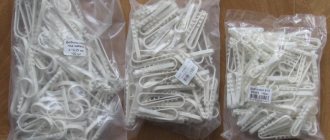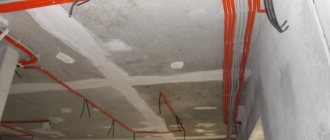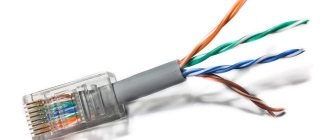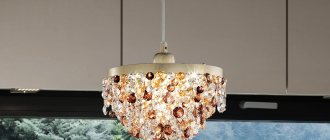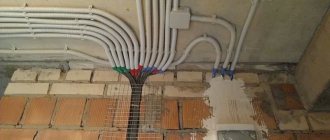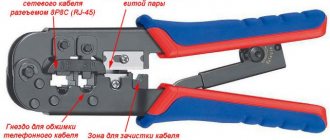Dowel fastener for cable
In most cases, electricians perform the functions of both a designer and an installer, because the objects are apartments and private houses.
Accordingly, no one will undertake an expensive power supply project. And the installer has to “draw” circuits in his head, and also think through routing methods and fasteners for different wires. Now almost all electricians know how to quickly and easily attach a cable to the wall. For this, a dowel clamp is used - a nylon bracket, very convenient for wiring the cable on the wall.
When the preparation of the walls is completed, it is time to plan the suspended ceilings. If the wire is laid under a suspended ceiling, then it will be interesting to know about all the types of fasteners that are commonly used. The latter are used, by the way, both for bare cables and for those laid in corrugation.
Attaching the cable to the wall must begin with the preparation of tools - something that an electrician cannot do without.
At a minimum, everyone should have:
A regular brand hammer drill with a standard 6 mm drill bit for drilling;
They make a hole and insert a dowel clamp with a cable clamp. The design of the product is such that it does not allow it to jump back thanks to the self-clamping mechanism. This way you can quickly secure the cable to the wall.
Hilti 14th screwdriver, which may or may not be useful;
You can limit yourself to a screwdriver used instead of a screwdriver. If fastening is carried out on such soft materials as wood, then you cannot do without a screwdriver.
Gun GX 120-ME, with which dowels are nailed;
The latter are loaded into the clip directly in the factory cassettes. The pistol needs to be reloaded periodically.
A stapler for fastening, which comes with two clamps: for a round cable and for a flat cable. Brackets for fastening low-voltage cables also come in two types for these types of cables.
The universal system operates on the principle of gas installation. The gas indicator allows you to install a new cylinder in time. The pistol comes with two muzzles that can be easily removed. One barrel is intended for electrical installation, the second - for general construction work on drywall. Both can be used for electrical wiring.
When using a pistol, it is mandatory to use protection - these are Hilti glasses and the simplest headphones. The mentioned protective equipment is included with the pistol. Next, we will look at ways to attach the cable in a building: to the wall or ceiling.
Features of choosing a dowel clamp
For fastening wires and cables, the correct choice of the type of external fastener is important. This depends, first of all, on the diameter of the wire products, its specific gravity, the structure of the walls and ceiling.
Design
The principle of the structure of a plastic clamp for electrical wiring is that the loop covers the cable and at the end folds into a rod (dowel) with external spikes. The simplest design of a dowel clamp is a strip of PVC 6-8 mm wide, which is folded in the shape of a toothed rod.
Plastic holder
The anchor fastener, designed to hold a large cross-section cable or several wires at once, looks like two rubberized metal half-rings, where the lower element has a metal threaded holder. The half rings are closed with screws threaded through the holes in the ebb of the segments. The fastener is supplied with plastic dowels.
Dowel clamps for fastening cables have considerable advantages:
- plastic products eliminate the mass of individual parts, such as clamps, dowels and screws;
- ease of installation significantly reduces the time required to install wires on the wall and ceiling of the room;
- PVC products can withstand temperatures ranging from -40 to 800C;
- clamps are insensitive to ultraviolet radiation;
- in case of repair, the fasteners can be easily and quickly dismantled;
- types of products are designed for different loads depending on the cross-section of conductors.
The disadvantages include the following:
- at high temperatures, plastic elements may become deformed;
- installation of anchor clamps is possible only in concrete and brickwork;
- External fasteners are not used in apartments and public buildings.
Application
Plastic dowel clamps are designed for fastening cables to walls with a diameter of up to 25 mm. Loop-shaped elements are most often made of nylon. They are used to secure wires on vertical fences. On the inside of the bracket, the manufacturer often indicates a range of cross-sectional sizes for the cable or group of wires. For example, the inscription 11-18 mm means that the clamp will not hold a conductor with a diameter of 20 mm.
For electrical wiring on the ceiling, fasteners are used, consisting of a separate plastic dowel and tie, which is fastened with a screw or threaded through the grooves of the support platform.
For heavy cable networks, metal anchor dowel clamps are installed. To do this, concrete, brick, and aerated concrete are drilled with a hammer drill.
Important! Attaching the cable to the ceiling and walls made of wood is a nail with a plastic or metal strip. Nail staples are used for installing wiring not only on wood, but also on plywood and chipboard
Peculiarities
The type of dowel-clamp fastener appeared on the construction market not too long ago. Due to their functionality, convenience and simplicity, hardware immediately won recognition among professional electricians. The dowel clamp is designed for laying and fixing cables in an open or closed way. It makes it possible to fix the main wiring of cables, wires, thin and flexible pipes to load-bearing supports made of materials such as concrete, stone, foam concrete, brickwork, as well as to wood or plasterboard.
- Using a dowel-clamp allows you to significantly save money when large volumes are involved - instead of a dowel-nail set, only one fastening element is used. Due to this same feature, installation is carried out much faster.
- Plastic hardware, and even more so metal, can withstand large temperature changes. Such a wide range allows the use of fasteners for both internal and external work in almost all regions of the country.
- The manufacturing material is in most cases resistant to ultraviolet rays.
- Fastening elements are capable of holding a large mass, and replacing failed ones is not difficult.
The dowel-clamp also has some disadvantages, although not too serious, compared to many of its advantages.
- The material from which plastic fasteners are made does not burn, but becomes plastic and deforms during a fire.
- Visually, the hardware does not look very attractive. But if you consider that the cable itself is not a decoration of the wall, this drawback of the dowel-clamp can be considered insignificant.
Staples and clips
Clamps are usually used to secure low voltage cables. Such fasteners can have a U or L-shaped design. Depending on the thickness of the cable, staples of the appropriate size are selected.
It is better to use staples with a plastic casing, this minimizes the risk of damage to the insulation. But, for wiring even a household electrical network, this type of installation is not recommended. This is the optimal solution for laying computer networks, telephone lines, etc.
A clip for fastening wires is a special steel or plastic structure through which cables are installed. Plastic clips are used when performing interior work.
Steel clips are suitable for use in open areas. It is best to use stainless steel fasteners, they are the most durable. Coated with paint or a layer of zinc are also strong, but less durable.
The most aesthetic and inconspicuous type of clip is a compact plastic clip with a nail. Such fasteners provide quick installation and are well suited for laying a single cable. Staples for thick wires or bundles of wires are more visible, but provide greater security.
Advantages of dowels, disadvantages of clamps
A simple and cheap device has a number of design advantages . They are economical, as they consist of one part, are easy to install, and are durable due to the material of artificial origin.
The device is not destroyed by ultraviolet radiation, can be repaired, has an increased load-bearing capacity, and can be operated at ambient temperatures of -400C...+850C. The disadvantages of the device include deformation from high temperature and the need for additional decoration.
General rules for fastening cables in grooves
The cable fastening is selected depending on the type of laying (open or closed) and the type of base
Safety rules note that in residential, public buildings and in production it is necessary to install wiring with non-combustible insulation or in a solid metal box. Experts provide several universal recommendations:
- the main task of fastening is to ensure reliable fixation without sagging;
- at turns of the route, the fastening elements can be moved 5-10 cm from the bend point;
- screws, self-tapping screws and dowels are tightened for support - this way the protruding cap will not damage the insulating layer;
- fastening is carried out with a maximum distance between points of 50 cm;
- laying is done strictly along a vertical or horizontal line, the stock is masked;
- Before finishing with plaster, the wire is positioned so that it does not interfere with the application of coatings;
- if there is a suspended or suspended ceiling, gating is not performed;
- For installation, use a drill, hammer drill, hammer and screwdriver.
The cable reserve can be rolled into a ring.
How to fasten
Before final finishing of the walls, you need to choose a method for fixing the wires.
Alabaster
Gypsum composition is used when it is necessary to quickly fasten the cable. The solution holds a small number of soft braided wires. Alabaster is applied in small portions. The main disadvantage is the rapid hardening of the mixture, which cannot be prepared in the required volumes.
Cable ties
Non-flammable plastic fasteners are suitable for installation on aerated concrete, brick, wood or concrete. It is used in combination with screws, screws and dowel nails. Before installation, a hole corresponding to the diameter of the fastener is formed. After this, the dowel is inserted, the tie-plate is hammered in, and the cables are laid on the finished route.
Dowel-ties
The product is a dowel-nail with a screed made of self-extinguishing plasticizers. The fasteners are equipped with one-piece or detachable locks. In the second case, you can supplement the bundle with new wires or remove unnecessary elements. Dowel ties are used for open or hidden laying of cables on brick or concrete surfaces.
Plastic dowel
Polyamide nails with a hole head help to quickly secure the cable in the groove. First, the fixing element is hammered in, then the cable is pulled through.
Dowel clamps
Products of different diameters are offered in white or black. The fastener has the form of a loop with clamps on the legs. Before installation, a groove is made, a clamp is placed, and wiring is laid. The disadvantage of this method is the need to strictly select the size of the fastener for the cable cross-section.
Dowel clips
The elements are used for open laying of wires. They look like curved strips with branches. Clips are suitable for securing small round or flat cables. Such elements are easy to install. It is enough to make a niche of the required size and insert a tourniquet into the clip. Electrical communications are fixed securely and look aesthetically pleasing.
Homemade devices
In the absence of specialized products, you can use improvised means:
- Dowels or nails. They are driven in before laying the wiring. A nail is used to pierce the central part of the telephone cable.
- Corrugated hose. It is cut into pieces, the length of which is slightly greater than the width of the channel. The tube is compressed and inserted into the groove. As the wall is plastered, the fasteners are removed.
- Perforated metal strips. Used to place across the pipe and secure bundles.
Aluminum plates
To secure the cables, sheets of metal cut into thin strips are used. Several wires are wrapped in a plate, which is drilled and secured to the bottom of the groove. The ends of the strip are folded after laying the cables.
Fasteners for organizing a bundle of conductors
When organizing workplaces, several different cables are checked.
To arrange the beams use:
- Installation sites. They are fixed to the surface using an adhesive layer. After this, the bundle is attached to the site using a standard tie.
- Cable clip with adhesive backing. It is suitable for fixing to plastic surfaces.
- Cable trays made of perforated metal, fixed to the ceiling.
Construction mixture
Used for hidden cable laying in wall and ceiling grooves. For this, gypsum mortar is often used. This type of installation has a special name - “freezing”. There is nothing complicated about this method. An alabaster mixture is made and the cable is tacked in the groove in places evenly spaced from each other. This should be done promptly, since the plaster sets quickly enough.
Plaster solution for fastening wiring
This “freezing” is well suited for installation of a single cable in a groove. But this method is also used as an additional fastening of several cables, to secure already installed brackets, dowels, clamps, etc. After all this, the groove channels are filled with plaster mortar.
If the laying volumes are large, frequent preparation of the solution and fixation of the cable significantly reduces the installation speed. But in many cases this is completely justified.
Design
A dowel-clamp is a fastener that can be used to attach wires or pipes, both hard and soft, to brick, aerated concrete, foam concrete. The dowel is made in the form of a loop with an oval or round end.
- At the ends of this loop there are teeth, which cling to the material when fixed.
- Dowel - clamp has such functions as holding a wire or other attached material (clamp) and fastening directly to the surface (dowel).
- These clamps are often produced in two colors, black and white, but if desired and necessary, you can find other colors. There are several types of dowels. Basic.
"Helicopter"
Fastening in the form of a loop with a spacer. This type can withstand loads of up to 8 kilograms. With this fastening, you can fix not only cables, but also pipes with different coatings and shapes, the diameter of which should not exceed 32 mm.
Bracket
A plastic strip with teeth, designed for fixing cables and pipes with a diameter of 6 to 25 mm. When calculating the number of fasteners, it is necessary to take into account the weight of the cable.
Arc Clamp
The shape of such a dowel is not in the form of a loop, but in the shape of an arc. And the diameter of the attached cable or pipe must match the size of the clamp. They are produced with one or two arcs, which allows the cables to be fastened in parallel.
Types and selection of dowel clamps
Plastic fasteners
Let's consider what main types of plastic dowel clamps, depending on their design, are used when installing wire lines and pipelines:
- An anchor clamp is a simple product designed for laying thin wires along a mounting panel. It resembles an ordinary thin plastic clamp, but unlike it, it is equipped with an anchor element, with which it is attached to a hole in the mounting panel. Not suitable for fastening in a solid base, since its anchor element works on the principle of a latch that opens into an open space after passing through the panel.
The simplest anchor-type clamp used for laying thin wires
- Dowel-clamp bracket is the most commonly used among this type of fasteners. It is a plastic bracket with teeth on each side, which, when the ends are aligned, turns into a loop. The popularity of this product is due to its simplicity and ease of installation, low cost, and versatility - it can be used to secure wires and pipes of various diameters.
The popular dowel clamp bracket is very easy to install and versatile
- Expansion-type dowel clamp or so-called helicopter. Such fasteners are also designed for fastening both wires and pipes, while being able to withstand a more significant load compared to previous options - usually up to 8 kg. It is a stamped structure in the form of a cross, vaguely reminiscent of a helicopter (hence it got its name), with a loop and a spacer rod, as well as two disconnected parts that are assembled into an anchor element. This is a more expensive, but also significantly more reliable type of fastener.
Spacer-type fasteners can withstand significant loads
There are other types of dowel clamps on sale, but they are less common and usually cost more.
As for the materials from which the above fasteners are made, there can be three types:
Nylon products. Such fasteners are the most popular because they are characterized by increased strength. At the same time, they are quite flexible and, in addition, remain so even at sub-zero temperatures, which makes installation possible with their help in the winter season.
The disadvantage of nylon dowels is a significant loss of mechanical properties at temperatures above 85 degrees, so they are not recommended for use when installing hot lines, such as heating pipelines.
- Polypropylene fasteners. Durable, but quite hard and not plastic products. Such clamps are afraid of direct sunlight, for this reason they are intended only for installation inside buildings.
- Polyethylene dowel clamps. The most budget option, characterized by low strength and a decrease in mechanical properties over time. In addition, it is also sensitive to ultraviolet light.
Metal fasteners
More durable metal dowel clamps are used for fastening heavy pipelines and thick cables, as well as when fastening into dense foundations made of brick and concrete. In most cases, such products are made of galvanized steel, less often - in conditions of high humidity or when exposed to chemical environments - from brass.
There are the following types of metal fasteners:
- Dowel-clamp bug. It is a combination of a metal dowel and a single-leg bracket, which presses the pipe or cable to the base when the dowel is screwed in. Designed for fastening highways with a diameter of up to 38 mm and a weight per fastener of up to 10 kg.
Simple in design and installation, but reliable dowel clamp bracket
- Dowel clamp with a screw-on clamp made of two brackets. The most popular solution when laying non-massive large-diameter pipelines, such as a chimney or plastic sewer pipe. Often sold with a rubber gasket.
Metal dowel with screw clamp suitable for large diameter household pipelines
- Fastening with tape. Available with either plastic or fiberglass tape or wire tape. The second type of product is chosen for laying hot lines. Dowel clamps with tape are quite versatile and are suitable for fastening almost any communications weighing up to 15 kg per fastener.
Dowel clamp with tape - an alternative option for fastening
Wire mounting area
A nylon, plastic or polypropylene installation platform with a rectangular clamp head is designed for laying a pipe, bundle of cables or hoses. It is mounted on a hard surface as follows: a dowel with a platform is placed in a hole through which a fixing metal or polymer clamp is threaded, a pipe or a bundle of wires is laid. The advantages of the device include quick and simple installation, the ability to place several telephone, television and electrical cables on the site.
Hidden electrical installation
When installing electrical wiring in a hidden way (in a groove under the plaster), there are more options for attaching wires and cables to the walls. Let's consider from the most simple and effective to the least convenient.
Dowel clamps
Dowel clamps, in fact, like dowel ties, are very convenient to use. These fasteners are low cost and also allow for quick electrical installation. Ties, of course, are more practical and versatile, so we recommend choosing them for fastening wires in a groove. All you need to do is drill a hole in a concrete, brick or wooden surface, insert a special dowel tie into it, and then drive in a special expansion peg.
Attaching a dowel clamp to the wall is even easier. You just have to drill a hole and then hammer the cable tie into it, as shown in the picture below. To attach the wire to drywall, we recommend using a special butterfly dowel into which the fasteners are already screwed (second picture).
By the way, if you already have electrical wiring along the walls and you need to attach another cable to it, you can use ordinary plastic clamps. For fastening in this way outdoors, it is recommended to use black clamps that are resistant to ultraviolet radiation!
Technology for fastening special staples
Using special ties
Quick drying solution
In order to quickly fasten wires and cables in the groove, you can use a quick-drying solution: alabaster or gypsum. In this case, you need to act hastily, because... the finished solution hardens very quickly, and you may not have time to fix the entire selected area in the wall. As a rule, the cable needs to be “frozen” in the prepared groove every 40 cm, as shown in the photo.
The advantage of this method of fastening the wire is that you do not need to spend much on material and, moreover, you can do without nails and without drilling walls. The main disadvantage is that the solution hardens quickly, so you need to dilute plaster or alabaster in small volumes. In addition, attaching more than two conductors to the wall will be very difficult.
Homemade staples
Fastening the cable to the wall using brackets will ensure reliable gripping of the conductor, and will also allow you to secure several groups of cables in one route. In order to attach conductors with brackets, you must first make these fasteners yourself. In this case, you will need either thin galvanized steel, cut into strips, or PTPZh aluminum wire. The length of each staple should be from 6 to 7 cm. You need to cut the material into suitable pieces, and then drill a suitable hole in the center of each. Then everything is simple - the wall is drilled in suitable places, after which the dowel is driven in and “quick installation” is carried out. You can also hammer the staples with nails if the fastening is carried out on wooden walls.
The disadvantages of this method are the long preparation time for homemade staples, the likelihood of damage to the conductor insulation (if strips of galvanized steel are used), as well as the possible appearance of red spots on the wallpaper if the steel begins to oxidize. We do not recommend using this option if you need to secure the wire in the wall under plaster, because... There are more modern and convenient installation methods. It is reasonable to use brackets to attach the heating cable of a heated floor system.
Installation site
Well, the last, one of the modern options that will allow you to fix the wire on tiles or furniture (for example, a table) is the use of mounting pads with one self-adhesive side (Velcro). Everything is very simple here, so there is no point in explaining the essence of the fastening. You can see the installation sites in the photo:
That's all the ways to attach wires and cables to the wall. As you can see, there is a wide range of fasteners that will allow you to choose the most suitable option for various application conditions.
Also read:
Errors when installing electrical wiring Methods for connecting electrical wires How to determine phase and zero without instruments
The most practical cable holder
As I already said, depending on the method of installing the electrical wiring, the attachment of the cable to a particular base also depends.
If the installation of electrical wiring is carried out hidden, then it is important to securely fix the wires in the groove so that they do not interfere with future finishing and plastering of the walls
For open wiring, they try to choose methods and accessories that are less noticeable to the eye and do not attract attention. Also, the cable fastening depends on the finishing methods in the room.
For example, if the ceilings in the apartment are suspended or suspended, and the cable routing runs along the ceiling, then there is no need to make grooves on it and cover the wires in them (they will already be hidden under the decorative finish)
Also, the cable fastening depends on the finishing methods in the room. For example, if the ceilings in the apartment are suspended or suspended, and the cable routes run along the ceiling, then there is no need to make grooves on it and cover the wires in them (they will already be hidden under the decorative finish).
What tools are needed to securely attach the cable to the wall? The surfaces you will have to work with can be made of concrete, brick, wood, so the minimum set of tools is a hammer drill, drill or screwdriver.
Dowel clamp for cable fastening
These mounts are designed to secure a single cable. It is very simple to secure the cable dowel with a clamp. To do this, we just need a hammer drill and a concrete drill with a diameter of 6 mm. First, a hole is drilled in the concrete to the required depth (depending on the length of the dowel itself), then the clamp is opened and the cable is inserted into it, after which the clamp is pushed into the hole.
There are notches on the sides of the clamp at an angle, which prevents it from falling out of the wall. If the size of the drill and clamp are chosen correctly, the dowel will never fall out of the hole.
The dowel clamp for fastening the cable can be in two versions: for flat and round cable.
The positive aspects are low cost, quick installation method, reliable fixation (you can be sure that the cable will not break under its own weight).
Using a dowel clamp, the cable can be fastened to concrete, brick, foam block, and decorative stone. Suitable for both open and hidden fixation of wires.
Mounting area for cable fastening
This cable fastener is made in the form of a square platform. They can be square or more oblong. I prefer to use the second option as they are more durable. There is a mounting hole inside for fastening. Sometimes in stores you can find the abbreviation PMO (platform with mounting hole).
Installation is also not difficult. To begin, drill a hole in concrete with a diameter of 6 mm, insert a regular dowel into it, and attach the platform to the base (wall or ceiling) with a self-tapping screw.
Then we take a regular nylon tie and use it to secure the cable to the site. This method allows you to attach several wires and cables to one platform. This means that fewer holes need to be drilled, which accordingly speeds up the installation process.
The positive aspect is ease of use, quick installation, and the ability to attach several cables to the site at the same time.
Dowel for bandage
In appearance it has something in common between a dowel and a self-tapping screw. Made from plastic. The mounting head is equipped with a hole through which you can insert a tie and secure the cable.
The installation principle is similar to the previous methods. We drill a hole with a diameter of 6 mm and hammer the bandage into it. Then we pass a tie through the hole and tie a cable or group of cables.
To be honest, I haven’t tried to secure the cable to the wall with such a bandage, so I can’t say anything about them.
Dowel tie for cable fastening
A dowel tie, or as it is also called a clamp with a dowel, is a convenient and versatile device. The device consists of two elements assembled into one whole: a dowel and a clamp (tie). This simplifies the installation process.
Open cable routing
The method of laying cables by directly attaching them to walls appeared at the dawn of electricity and has remained virtually unchanged since then. A clamp, clamp or mounting bracket was secured to the supporting structure with a separate fastening element and secured the wire. In this case, a wide variety of fasteners were used, depending on the material of the walls, ranging from a simple nail to an anchor. For an ordinary brick or reinforced concrete surface, the entire process consists of the following operations:
- Drilling a hole in a wall or ceiling.
- Installing a plastic dowel.
- Fixing the cable in the mounting bracket.
- Fastening the mounting bracket to the wall with a self-tapping screw.
And although the process is quite simple, the use of dowel clamps allows you to speed up and simplify it.
A dowel clamp for fastening a cable is a plastic part that combines the functions of an embedded part and a clamp holding the cable. Using this fastener, there is no need to separately hammer in the dowel, fix the cable and attach the clamp. All actions are performed in one step.
Main types of dowel clamps
All fasteners of this type are divided into two groups. The first type includes plastic dowels, and the second - metal. The first option, with which round and flat cables are fixed, will be considered in more detail.
Products of this type are in turn divided into the following categories:
- Fastenings for round cable. They are a classic version in the form of a tie with side teeth.
- Flat cable fasteners. Reminiscent of the “classic”, but differs in its flat head configuration.
The design of the dowels may also differ. In addition to the classic plastic jagged strips - “herringbones”, designed for thin wires, there are so-called expansion dowel clamps, known as “helicopters”. In this design, the loop is expanded by a plastic rod. This fastener can withstand a load of up to 8 kg, which makes it possible to fasten not only wires, but also various types of cables, as well as smooth-walled and corrugated pipes with a diameter of up to 32 mm.
Expansion dowels are available in two versions: in the first case, the rod is already placed in the dowel when it is driven into the wall. This design has increased rigidity, which requires care and precision during installation.
In another version, the fastener is not a loop, but an arc and is designed for a certain diameter of cables and pipes. That is, the diameters of the dowel and the fastened product must match as accurately as possible. The design can have one or two arcs, which allows you to fasten two cables in parallel at once.
So-called mounting platforms with clamps are often used. They are made in the form of a regular plastic dowel with teeth and a rectangular loop at the end. The clamp is threaded into this loop, which is the lock. This design allows you to attach bundles of wires of different thicknesses or pipes with different diameters.
The most commonly used material is nylon, as well as polyethylene and polypropylene. The latter option has increased strength and hardness. Increased sensitivity to light is compensated by special stabilizers, which makes the product more expensive. Therefore, in enclosed spaces, ordinary dowel clamps are used, regardless of their reaction to ultraviolet radiation.
Laying wires in the cable channel and installing sockets and switches
Correct installation of SIP cable: how it is done and what is needed for it
Laying the cable in the cable channel: installation instructions with photos
SIP installation: rules for fastening, laying, connecting
Installing sockets in drywall: installation features, fastening methods, how to install correctly
Attaching a chandelier to a suspended ceiling
Types of products
Dowel clamps do not have a wide variety of categories and types, since they are highly specialized products. However, there are options for design features and materials of manufacture. For example, metal and plastic.
By design features
This criterion allows us to distinguish three main types of fastening:
The staples are ordinary plastic strips with teeth to prevent backlash. Suitable for fastening wiring with a total diameter of 6-25 mm. The number of components depends on the weight of the cable. The technology can be used to fasten corrugated and smooth pipes of similar diameter. Mounting platform with clamp. When examining this product, you will find a plastic dowel with standard teeth, the end of which is equipped with a rectangular loop. The clamp must be threaded through the loop and the cable secured. The advantage of this method is the ability to tighten corrugations or bundles of wires of different diameters. Spacers or “helicopters”. The design involves the use of a dowel with a loop, inside of which you need to insert a plastic rod for a spacer. The maximum permissible load is 8 kg. You can attach cables, bundles of wires, corrugation with a diameter of up to 32 mm. Expansion dowel clamps are divided into two separate types. In the first case, the product is solid, the rod is installed in a dowel and driven into the wall along with it
The rigidity of the structure increases, but you must be careful when working with it, since first the cable or corrugation is threaded through the clamp, and only then the dowel is driven into the wall. The second type of spacer dowel clamps is an arched fastener without a loop. In this case, you can install a corrugation, wire or cable bundle of a fixed diameter
That is, there is no suitable range, and the diameter of the cable must match the diameter of the arc. There are spacers with one or two arcs for parallel fastening of two corrugated pipes or wires.
According to screed materials
We are talking about the choice of material for making cable fasteners. Ties (clamps) can be made from nylon, polyethylene or polypropylene. Let's look at each of them separately:
- The most popular material is nylon. This is due to the increased strength and maximum load of polyamide components compared to polyester (which include the other two types of plastic). The material can be used at temperatures up to +85 degrees. Celsius. Higher temperatures lead to a reduction in the tensile strength of the nylon tie by 5-10 times. An excellent option for cables and wire bundles, but not suitable for fixing heating pipes.
- Polyethylene clamps are cheaper products with increased sensitivity to ultraviolet radiation, so they cannot be used outdoors. You can use dowel clamps made of stabilized polyethylene, but even in this case, over time, fragility increases and the load-bearing capacity of the products decreases.
- Polypropylene ties are durable and rigid products compared to polyethylene, but also sensitive to light. By adding a stabilizer, you can increase UV resistance, but this will increase the cost of the components. Since installation is often carried out inside buildings, sensitivity to ultraviolet radiation is not such a noticeable disadvantage.
Methods of fastening to walls made of various materials
It is a mistake to believe that wiring can be fixed to any flat surface. Load-bearing structures and partitions are constructed from materials with different properties:
- thin, soft;
- dense;
- solid.
Wall surfaces made of porous materials (foam, aerated concrete) are considered soft. This group also includes plasterboard, plastic, and fiberboard. These materials are able to withstand moderate loads, but are deformed under the influence of strong pressure. To prevent destruction of the entire structure, you should choose methods for attaching the cable to the wall based on the use of fasteners that have an extended middle/end part. These can be dowels of different types.
The group of dense materials includes chipboard, wood, and gypsum. Surfaces covered with plaster are also durable. The top layer of the material has a dense structure. If the question of how to fix the cable on such a wall is being decided, two options are considered: nails, self-tapping screws.
The first one is less reliable. Such fasteners can be dispensed with if they are used as a temporary measure or if this area will not be used in the future. Due to mobility, the strength of fixation of the nail in the wall decreases. To secure the screws, holes of a smaller diameter are first made. However, this measure is used only if the fasteners are difficult to install.
Solid materials: concrete, brick. On such walls, dowels are attached, and then holders with screws (staples, clamps, ties, etc.). When you need to install a cable on a brick or concrete wall, the diameter of the hole must correspond to the size of the dowel. In other cases, the difference should be 1 mm.
Methods of attachment to different surfaces
Walls and ceilings are made from various materials with different structures and densities. Depending on this characteristic, the method of fastening changes:
- Dense - wood in any form, plaster and soft plaster solutions (including gypsum). A nail or self-tapping screw fits perfectly into all these materials. In some - chipboard, OSB and some others - it is better to first drill a hole with a slightly smaller diameter than a self-tapping screw, and then screw it in. Nails are often driven in immediately without pre-drilling. Self-tapping screws are screwed into wood and products made from it. Only for attaching the cable it is better to take them with a flat head
- Solid.
This category of materials includes brick, concrete, screeds, and cements. You can’t screw a self-tapping screw into them even with a pre-drilled hole. For such materials, dowel-nails are used (they are also called dowels). This is a fastener consisting of two parts - a plastic dowel cap and a metal (sometimes plastic) screw. In such cases, a hole is drilled in the material with a drill diameter equal to or slightly smaller than the diameter of the dowel. A plastic cap is inserted into the hole. Its top edge should be flush with the surface (if necessary, you can hit it a couple of times with a hammer to level it or cut off the excess with a sharp knife). Then a fastening element (plate, clamp, etc.) is applied, which is attached to the inserted dowel with a screw. Dowel installation - Thin or soft.
These are plastic, plasterboard, fiberboard, aerated concrete, foam concrete, etc. The usual fasteners do not hold in them; you need a special one, which has an extended “back” part. It has a large support area, due to which the fasteners can be held. Some examples of such fasteners (umbrella, butterfly dowel and dowel with drill) are presented in the photo. To attach the cable to thin walls, you need special fasteners.
Actually, these are all the surfaces that are encountered inside the house when laying wiring. But sometimes the cable also needs to be attached to a pole, for example, when the electricity supply from the pole to the house stretches, or to a pipe - when the cable rises along a flammable wall.
To a concrete pillar
The cable is secured to the reinforced concrete pole with long black plastic ties. They last about 5 years.
One way to lower a cable along a reinforced concrete pole
You can use clamps to install sewer pipes, but you need to drill holes for them, which is very difficult. Another option is if there is a grounding wire on the pole - a round wire with a diameter of 5-6 mm, then you can attach it to it with ties. Another option is to attach strips of metal to the pole - make something like clamps, and attach the cable to them.
In a metal pipe
If the cable runs up the wall of a house in a metal pipe, it is simply run inside. Since quite solid cables are used for external wiring, its rigidity is usually enough to more or less stay inside the pipe.
Laying cable in a pipe. Fasten the pipe, and the cable only at the exit from it to the wall
The pipe is closed at the top and bottom with some kind of plug (can be cut out of foam plastic and then painted along with the pipe). This plug will additionally fix the position of the cable (do not press it to the edge), and so that it does not move inside the pipe, it is attached to the wall at the exit from it.
To the cable
To attach the cable to the cable, special metal and plastic hangers are used. They consist of two parts - there is a hole for the cable and a larger one for laying cables.
Suspensions for attaching the cable to the rope
Which is better - metal or plastic? Metal ones are more durable, but take longer to install - you need to tighten the screw. Plastic ones will last about 5 years, but are installed quickly - the “tail” is pulled into the corresponding hole and tightened. That's all.
